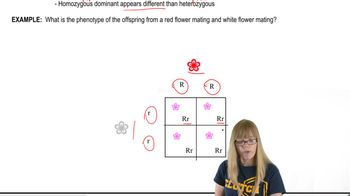Here are the essential concepts you must grasp in order to answer the question correctly.
Hardy-Weinberg Principle
The Hardy-Weinberg Principle is a fundamental concept in population genetics that describes how allele and genotype frequencies remain constant from generation to generation in a population under certain conditions. These conditions include a large breeding population, random mating, no mutation, no migration, and no natural selection. This principle provides a baseline to compare actual genetic variation in populations.
Recommended video:
Autosomal Dominance
Autosomal dominance refers to a pattern of inheritance where only one copy of a dominant allele is necessary for the expression of a trait. In the case of PTC tasting, the ability to taste is dominant, meaning individuals with at least one dominant allele (T) will be tasters, while those with two recessive alleles (tt) will be nontasters. Understanding this concept is crucial for calculating genotype frequencies based on phenotype ratios.
Recommended video:
Genotype Frequencies
Genotype frequencies represent the proportion of different genotypes in a population. In the context of the Hardy-Weinberg equation, these frequencies can be calculated using the allele frequencies. For a trait with two alleles, the frequencies of homozygous dominant (TT), heterozygous (Tt), and homozygous recessive (tt) genotypes can be derived from the overall frequency of the dominant and recessive phenotypes, allowing for predictions about genetic variation in populations.
Recommended video:






